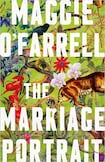
In Emma, Jane Austen wrote that “a woman is not to marry a man merely because she is asked, or because he is attached to her, and can write a tolerable letter”. We don’t think of the early 1800s as being a period of freedom for women but it’s positively libertine compared with the 1560s, where Maggie O’Farrell’s new novel is set. Its heroine, 16-year-old Lucrezia de’ Medici would surely have been bewildered by the concept of being “asked”. Decisions about marriage were the business of men, and daughters were commodities to be traded on the international market like bullion turned flesh and blood.
Reading The Marriage Portrait, I was reminded of those contemporary woman-in-jeopardy crime thrillers that soar up the bestseller charts, usually with high-concept conceits, only transplanted to the Renaissance era, with less booze and better writing. O’Farrell turns a familiar structure on its head, however, in her introductory note, where she tells us that, despite her youth, Lucrezia was dead within a year of her marriage to Alfonso II d’Este, Duke of Ferrara. “The official cause of her death was given as ‘putrid fever’, but it was rumoured that she had been murdered by her husband.”
It’s unusual for a novelist to tell us how the story ends before it’s even begun, but it’s a clever choice because when we first meet the couple it seems that Lucrezia might have struck gold, for Alfonso appears both kind and solicitous towards his child bride. Yes, he expects a brood of children to further his line and maintain his grip on the Duchy, but there’s nothing strange in that. Even the fact that he marries her after his previous fiancée, Lucrezia’s older sister, dies isn’t out of step with royal inclinations. For centuries this was an accepted form of aristocratic marriage; as late as 1893, George V married his dead brother’s intended, Mary of Teck, less than 18 months after the prince’s death.
Dragged away from Florence, Lucrezia is lonely and homesick, but hopes that she and her husband will become a devoted couple. One of the more striking elements of this novel is the portrayal of her own parents’ union, which is loving, sensual and anachronistically monogamous. It has given Lucrezia the gift of a happy childhood but the curse of an unrealistic notion of marriage, which becomes ever more apparent to her as Alfonso, having secured his prize, quickly loses interest in benevolence and is inconsiderate towards her in the bedroom. When she dares to offer her thoughts on the political situation in Italy and the troubles within his family, sparked by religious differences, it’s clear that he could not be more astonished if his horse had turned around and started speaking to him. All aspirations towards an affectionate and supportive partnership quickly fall from Lucrezia’s mind and she’s faced with the reality of her situation; she is a brood mare, nothing more, and her continuing inability to become pregnant places her life in peril.
Old Kiln by Jia Pingwa: An unforgettable masterpiece depicting rural China during the Cultural Revolution
Ciarán Murphy: At 42 I took up hurling, the world’s most frustrating and beautiful sport
Where a cherry costs £1: Ordinary London neighbourhoods falling to gentrification
CMAT takes a pop at former taoiseach Bertie Ahern in new Euro-Country single
It is Lucrezia’s creativity, however, that dominates much of O’Farrell’s narrative. She’s a skilful artist, painting small miniatures of animals and birds, and becoming ever more proficient as time passes. Even Alfonso is impressed by her talent, although, of course, this tiny grab for independence is something that cannot be sanctioned, and she is soon deprived of her tools.
The title comes from a portrait the duke has commissioned of his wife, for which she is forced to sit for hours at a time while he dictates her pose and clothing, and the contrast between the inauthentic nature of the painter’s work and Lucrezia’s own skill is well drawn. As she stares in the direction of an enormous easel, she is portrayed as a model wife who will doubtless fulful her maternal duties, increasing the couple’s status as a symbol of unity and power. And yet it is only in the tiny scraps of canvas upon which Lucrezia fashions her renderings that honesty can be found.
After the success of Hamnet, O’Farrell appears to be embracing the historical form, for this is another gripping narrative with a passionate and resourceful character at its heart. Just as we knew that Hamnet could not survive his own story, so we are led to believe that Lucrezia cannot survive hers, and yet in both cases the reader is intrigued and eager to know how the characters will reach their end. It’s a measure of O’Farrell’s skill that we keep hoping against hope that the resolution will be different from the one that we have expected from the outset.
John Boyne’s new novel, All the Broken Places, will be published by Doubleday this month















